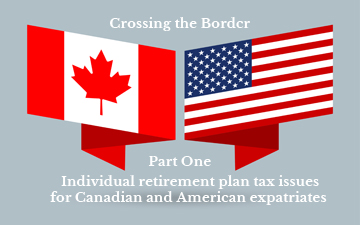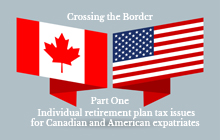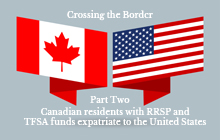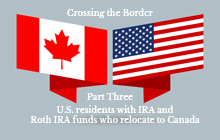Crossing the border, part one: Individual retirement plan tax issues for Canadian and American expatriates

In the first part of a three-part series on cross-border tax issues, Professor George Gonzalez presents an overview of individual employee retirement plans in Canada and the United States
 |
George Gonzalez, PhD is Associate Professor at the Calgary campus of the University of Lethbridge. He is a Chartered Professional Accountant (CPA, CA, Ontario) and a Certified Public Accountant (CPA, Florida). |
TO SAVE for retirement, some employed individuals set up a tax-advantaged retirement savings account, typically a Registered Retirement Savings Plan (RRSP) and/or a Tax-Free Savings Account (TFSA). If the individual were to work in the United States at some point in their career, they might also set up a similar tax-advantaged U.S. retirement vehicle in accordance with U.S. pension and tax law[1].
In cross-border situations in which a Canadian resident expatriates to the U.S. (and becomes a U.S. resident) or, conversely, a U.S. resident moves to Canada, tax planning issues unique to such individual retirement plans may arise. This is the first of a three-part series that focuses on cross-border tax issues related to individual employee-established retirement plans.
Among the issues addressed in this article series are: exit taxes when an individual expatriates from Canada to the U.S., and vice versa; taxation of the individual’s employee retirement plan by each country during the phases of the retirement plan; transferring funds from a Canadian plan to a U.S. plan, and vice versa; information reporting obligations imposed on these plans by each country.
For tax practitioners, a key element of sound tax planning is often simple awareness of potential issues in different client situations. This series of articles uses a systematic framework for discussing the cross-border tax issues, with the aim of making the information easy to reference for a particular client scenario.
In this first article in the series, general information about individual employee retirement plans is presented in a framework based on the main phases during the life of a retirement plan. The second article addresses situations in which a Canadian resident with Canadian registered plans (RRSP and TFSA) expatriates to the United States. The third and last article in the series discusses the reverse situation, in which a U.S. resident with U.S. qualified plans (IRA and Roth IRA) expatriates to Canada.
1. Taxation Basics of Employee Retirement Plans
It is worth first briefly discussing a few pieces of basic information related to individual employee retirement plans.
The main types of tax-advantaged retirement plans that an employed individual may establish in Canada and the U.S. are:
- Canada: Registered Retirement Savings Plans (RRSPs) and Tax-Free Savings Accounts (TFSAs)
- U.S.: Individual Retirement Accounts (IRAs) and Roth IRAs
Under both Canadian and U.S. tax law, the income taxation rules related to retirement plans can be separated into the three main phases of a retirement plan’s existence: (1) the contribution phase, (2) the accumulation phase, and (3) the distribution phase. For each of these three phases, the basic income tax rules may be stated as:
|
|
* * * * * * * * * * * * * * * P h a s e * * * * * * * * * * * * * * * |
||
|
Plan Type |
Contribution |
Accumulation |
Distribution |
|
RRSP (Canada) |
Contributions are tax-deductible. |
Income earned within the account is not currently taxable. (Taxation is deferred until funds are distributed.) |
Distributions of both principal and income are taxable. |
|
|
|
|
|
|
TFSA (Canada) |
No tax deduction for contributions. |
Income earned within the account is not taxable. |
Distributions of both principal and income are tax-free. |
|
|
|
|
|
|
IRA (U.S.) |
Contributions are tax-deductible[2]. |
Income earned within the account is not currently taxable. (Taxation is deferred until funds are distributed.) |
Distributions of both principal and income are taxable. |
|
|
|
|
|
|
Roth IRA (U.S.) |
No tax deduction for contributions. |
Income earned within the account is not taxable. |
Distributions of both principal and income are tax-free. |
As can be seen in the table, in terms of the three main phases of a retirement plan:
- Canadian RRSPs are taxed in Canada like IRAs are taxed in the U.S.
- Canadian TFSAs are taxed in Canada like Roth IRAs are taxed in the U.S.
Using the three phases described above as our framework, we will proceed to review several cross-border tax issues that arise when an individual with funds in an employee retirement account changes their residency from Canada to the U.S., or vice versa. The key questions we examine can be posed as:
1. For a Canadian resident with RRSP and TFSA funds who expatriates to the U.S.:
a. Are there Canadian departure tax ramifications?
b. What are the Canadian taxation rules applicable to a Canadian non-resident’s RRSP and TFSA?
c. What are the U.S. taxation rules applicable to a U.S. resident’s RRSP and TFSA?
d. Is it possible to directly transfer funds from a Canadian RRSP to a U.S. IRA?
e. Is it possible to directly transfer funds from a Canadian TFSA to a U.S. Roth IRA?
f. What are the Canadian information reporting requirements, if any, for a Canadian non-resident’s RRSP and TFSA?
g. What are the U.S. information reporting requirements, if any, for a U.S. resident’s RRSP and TFSA?
2. For a U.S. resident with IRA and Roth IRA funds who becomes a resident of Canada:
a. Are there U.S. exit tax ramifications?
b. What are the U.S. taxation rules applicable to a U.S. non-resident’s IRA and Roth IRA?
c. What are the Canadian taxation rules applicable to a Canadian resident’s IRA and Roth IRA?
d. Is it possible to directly transfer funds from a U.S. IRA to a Canadian RRSP?
e. Is it possible to directly transfer funds from a U.S. Roth IRA to a Canadian TFSA?
f. What are the U.S. information reporting requirements, if any, for a U.S. non-resident’s IRA and Roth IRA?
g. What are the Canadian information reporting requirements, if any, for a Canadian resident’s IRA and Roth IRA?
In the next article we proceed to explore the first set of tax issues. Specifically, we will look at the tax implications when a Canadian with Canadian RRSP and TFSA funds expatriates to the United States. In the third article we examine the tax implications when an individual with U.S. IRA and Roth IRA funds moves to Canada.
FOOTNOTES
[1] An employed individual could also be a participant in an employer-sponsored plan. In Canada these include CRA-registered plans such as Registered Pension Plans (RPPs), Pooled Registered Pension Plans (PRPPs), defined benefit pension plans, and money purchase plans. In the U.S. these include IRS-qualified plans such as 401(k) plans, Simplified Employee Pension plans (SEPs), defined benefit pension plans, and defined contribution plans. The focus of this article is registered/qualified employee retirement plans established by an individual; employer-sponsored plans are outside the scope of this article and are not discussed herein.
[2] While contributions to an IRA plan are generally deductible, some or all of a particular year’s contribution may not be deductible, depending on variables such as the taxpayer’s filing status, income for the year, whether the individual is covered under an employer-sponsored plan, etc. Non-deductible contributions create the need to track deductible versus non-deductible contributions made to the plan and affect the calculation of income tax during the distribution phase. For simplicity, this article assumes that all contributions to a U.S. IRA are deductible.
George Gonzalez, PhD is Associate Professor at the Calgary campus of the University of Lethbridge. He is a Chartered Professional Accountant (CPA, CA, Ontario) and a Certified Public Accountant (CPA, Florida). Title image: iStock (modified). Author photo courtesy George Gonzalez. Read the entire three-part series:
Crossing the border, part one: Individual retirement plan tax issues for Canadian and American expatriates
Crossing the border, part two: Individual retirement plan tax issues for Canadian and American expatriates
Crossing the border, part three: Individual retirement plan tax issues for Canadian and American expatriates






_Option 1_20251029123439.png)



(0) Comments